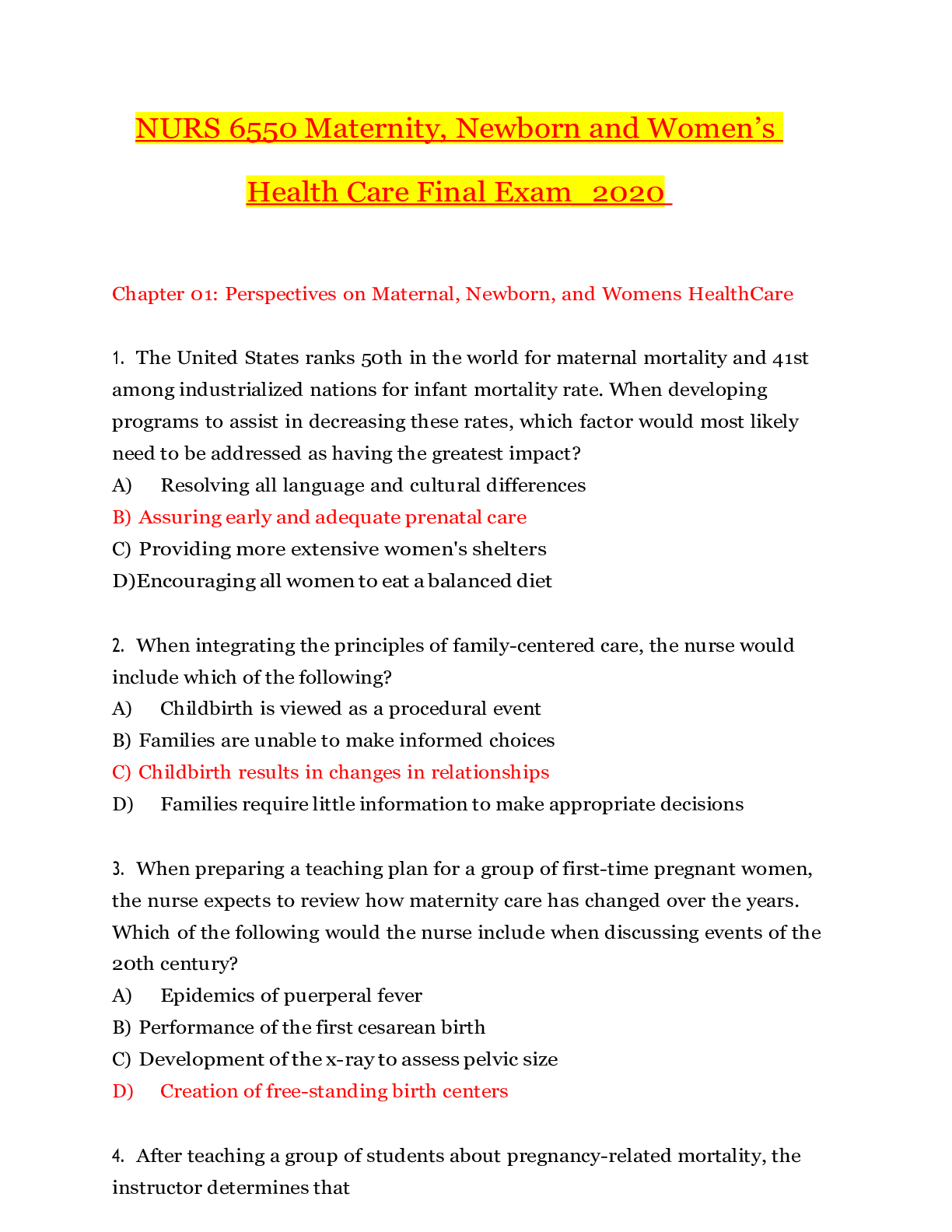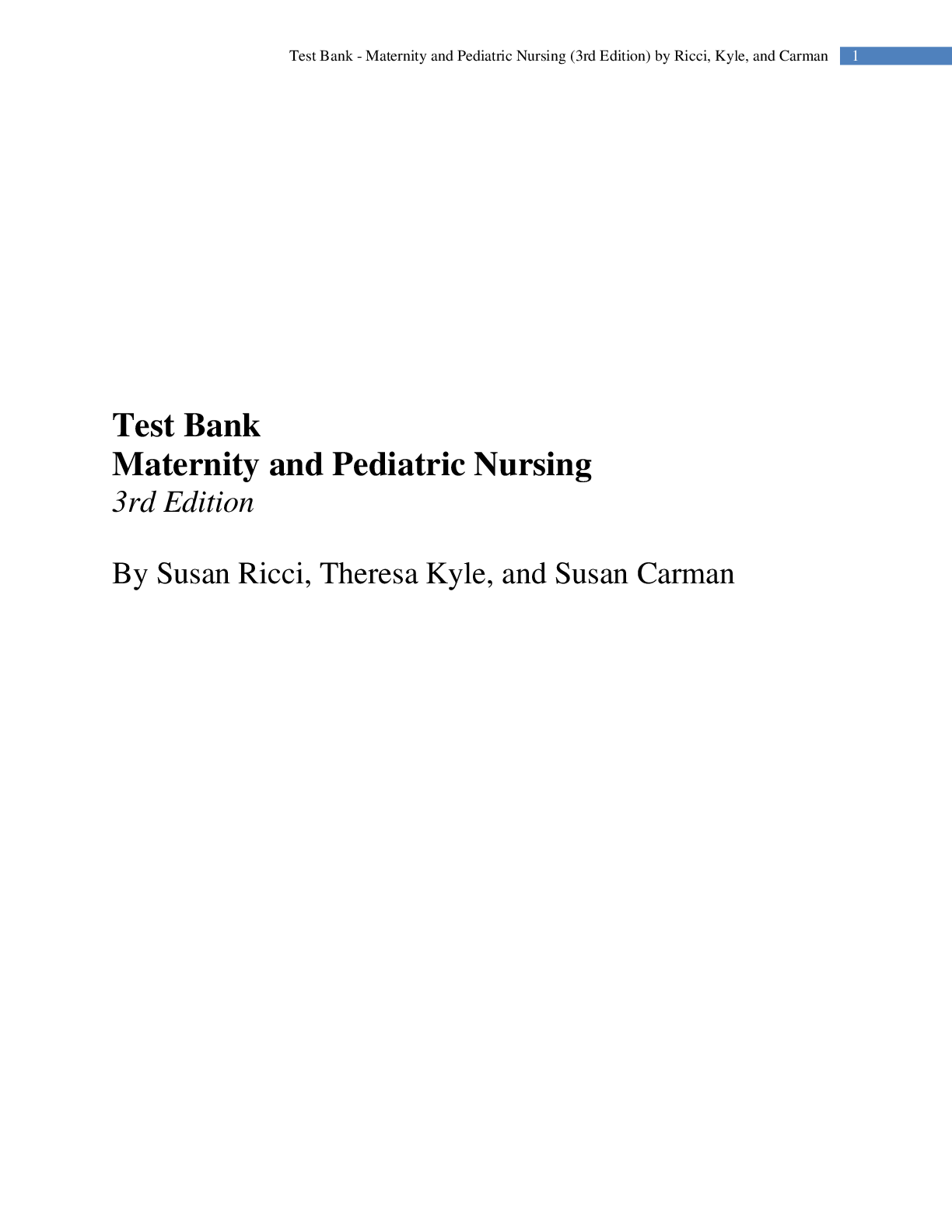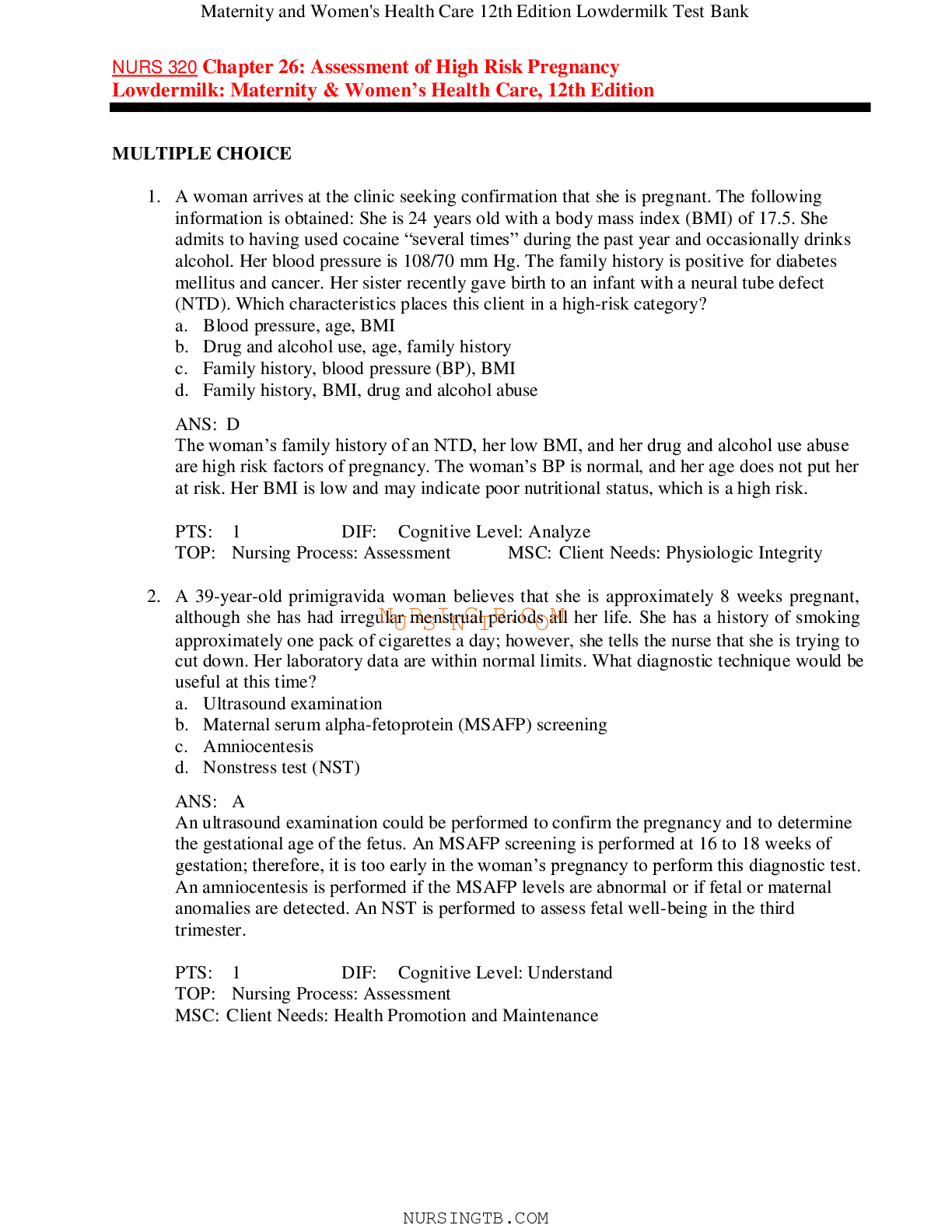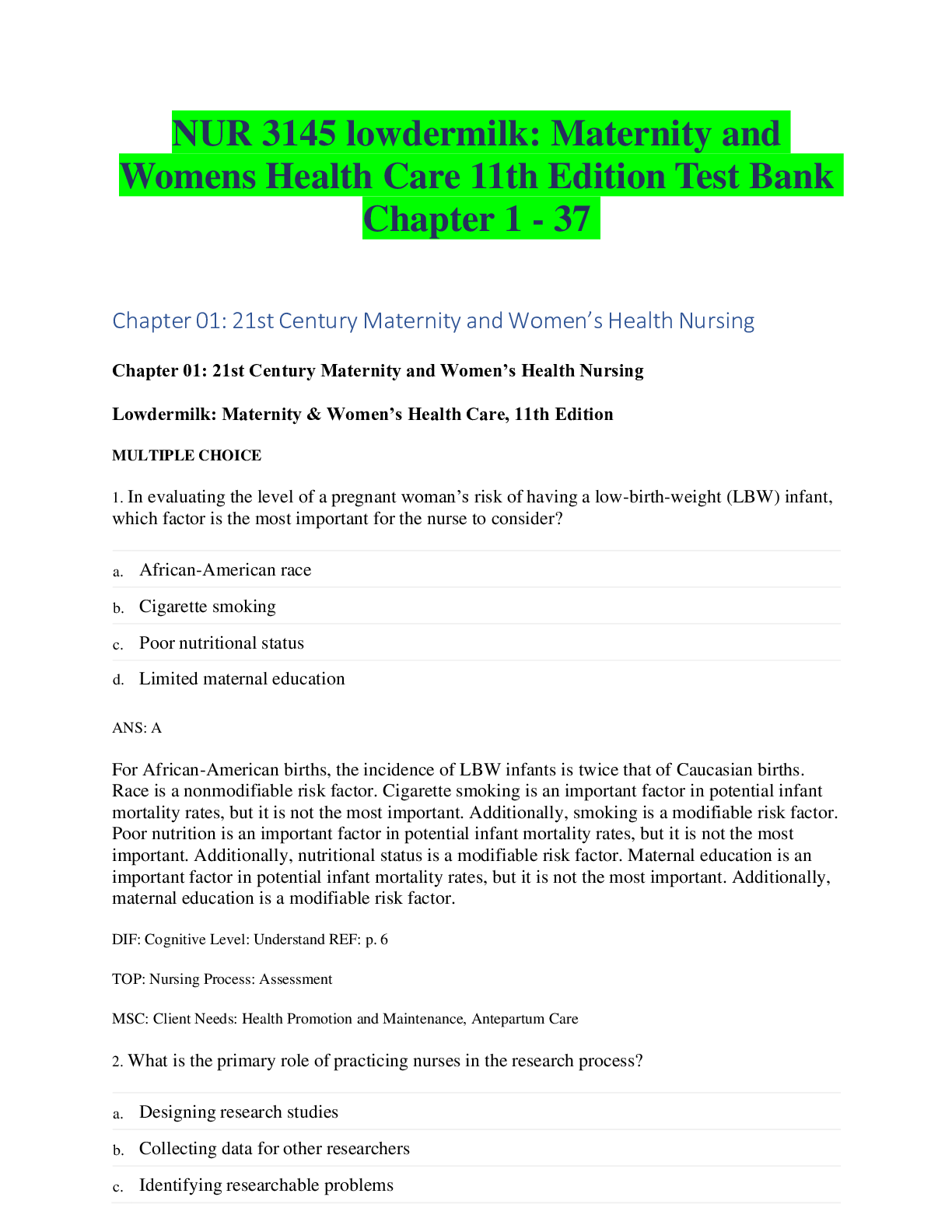*NURSING > EXAM > NUR 300 WI Maternity & Women’s Health Care 12th Edition (2019/2020) - Chapter 17 – Central Michi (All)
NUR 300 WI Maternity & Women’s Health Care 12th Edition (2019/2020) - Chapter 17 – Central Michigan University | Maximizing Comfort for the Laboring Woman
Document Content and Description Below
NUR 300 WI Maternity & Women’s Health Care 12th Edition - Chapter 17 – Central Michigan University Chapter 17: Maximizing Comfort for the Laboring Woman MULTIPLE CHOICE 1. An 18-year-ol... d pregnant woman, gravida 1, para 0, is admitted to the labor and birth unit with moderate contractions every 5 minutes that last 40 seconds. The client states, My contractions are so strong, I dont know what to do. Before making a plan of care, what should the nurses first action be? a. Assess for fetal well-being. b. Encourage the woman to lie on her side. c. Disturb the woman as little as possible. d. Recognize that pain is personalized for each individual. Each womans pain during childbirth is unique and is influenced by a variety of physiologic, psychosocial, and environmental factors. A critical issue for the nurse is how support can make a difference in the pain of the woman during labor and birth. This scenario includes no information that would indicate fetal distress or a logical reason to be overly concerned about the well-being of the fetus. The left lateral position is used to alleviate fetal distress, not maternal stress. The nurse has an obligation to provide physical, emotional, and psychosocial care and support to the laboring woman. This client clearly needs support. DIF: Cognitive Level: Apply REF: IMS: 381 TOP: Nursing Process: Diagnosis MSC: Client Needs: Physiologic Integrity, Psychosocial Integrity 2. A woman who is pregnant for the first time is dilated 3 cm and having contractions every 5 minutes. She is groaning and perspiring excessively; she states that she did not attend childbirth classes. What is the optimal intervention for the nurse to provide at this time? a. Notify the womans health care provider. b. Administer the prescribed narcotic analgesic. c. Assure her that her labor will be over soon. d. Assist her with simple breathing and relaxation instructions. By reducing tension and stress, both focusing and relaxation techniques will allow the woman in labor to rest and conserve energy for the task of giving birth. For those who have had no preparation, instruction in simple breathing and relaxation can be given in early labor and is often successful. The nurse can independently perform many functions in labor and birth, such as teaching and support. Pain medication may be an option for this client. However, the initial response of the nurse should include teaching the client about her options. The length of labor varies among individuals, but the first stage of labor is the longest. At 3 cm of dilation with contractions every 5 minutes, this woman has a significant amount of labor yet to experience. DIF: Cognitive Level: Apply REF: IMS: 386 TOP: Nursing Process: Implementation MSC: Client Needs: Physiologic Integrity 3. Nursing care measures are commonly offered to women in labor. Which nursing measure reflects the application of the gate-control theory? a. Massage the womans back. b. Change the womans position. c. Give the prescribed medication. d. Encourage the woman to rest between contractions. According to the gate-control theory, pain sensations travel along sensory nerve pathways to the brain, but only a limited number of sensations, or messages, can travel through these nerve pathways at one time. Distraction techniques, such as massage or stroking, music, focal points, and imagery, reduce or completely block the capacity of the nerve pathways to transmit pain. These distractions are thought to work by closing down a hypothetic gate in the spinal cord, thus preventing pain signals from reaching the brain. The perception of pain is thereby diminished. Changing the womans position, administering pain medication, and resting between contractions do not reduce or block the capacity of the nerve pathways to transmit pain using the gate-control theory. DIF: Cognitive Level: Apply REF: IMS: 383 TOP: Nursing Process: Implementation MSC: Client Needs: Physiologic Integrity 4. Breathing patterns are taught to laboring women. Which breathing pattern should the nurse support for the woman and her coach during the latent phase of the first stage of labor if the couple has attended childbirth preparation classes? a. Slow-paced breathing b. Deep abdominal breathing c. Modified-paced breathing d. Patterned-paced breathing Slow-paced breathing is approximately one half the womans normal breathing rate and is used during the early stages of labor when a woman can no longer walk or talk through her contractions. No such pattern called deep abdominal breathing exists in childbirth preparation. Modified-paced breathing is shallow breathing that is twice the womans normal breathing rate. It is used when labor progresses and the woman can no longer maintain relaxation through paced breathing. Patterned-pace breathing is a fast, 4:1 breathe, breathe, breathe, blow pattern that is used during the transitional phase of labor just before pushing and delivery. DIF: Cognitive Level: Understand REF: IMS: 387 TOP: Nursing Process: Implementation MSC: Client Needs: Physiologic Integrity 5. A laboring woman has received meperidine (Demerol) intravenously (IV), 90 minutes before giving birth. Which medication should be available to reduce the postnatal effects of meperidine on the neonate? a. Fentanyl (Sublimaze) b. Promethazine (Phenergan) c. Naloxone (Narcan) d. Nalbuphine (Nubain) An opioid antagonist can be given to the newborn as one part of the treatment for neonatal narcosis, which is a state of central nervous system (CNS) depression in the newborn produced by an opioid. Opioid antagonists, such as naloxone (Narcan), can promptly reverse the CNS depressant effects, especially respiratory depression. Fentanyl (Sublimaze), promethazine (Phenergan), and nalbuphine (Nubain) do not act as opioid antagonists to reduce the postnatal effects of meperidine on the neonate. DIF: Cognitive Level: Apply REF: IMS: 395 TOP: Nursing Process: Planning | Nursing Process: Implementation MSC: Client Needs: Physiologic Integrity 6. What should the laboring client who receives an opioid antagonist be told to expect? a. Her pain will decrease. b. Her pain will return. c. She will feel less anxious. d. She will no longer feel the urge to push. Opioid antagonists such as naloxone (Narcan) promptly reverse the CNS-depressant effects of opioids. In addition, the antagonist counters the effect of the stress-induced levels of endorphins. An opioid antagonist is especially valuable if the labor is more rapid than expected and the birth is anticipated when the opioid is at its peak effect. The woman should be told that the pain that was relieved by the opioid analgesic will return with the administration of the opioid antagonist. Her pain level will increase rather than decrease. Opioid antagonists have no effect on anxiety levels. They are primarily administered to reverse the excessive CNS depression in the mother, newborn, or both. An opioid antagonist (e.g., naloxone) has no effect on the mothers urge or ability to push. The practice of giving lower doses of IV opioids has reduced the incidence and severity of opioid-induced CNS depression; therefore, opioid antagonists are used less frequently. DIF: Cognitive Level: Apply REF: IMS: 395 TOP: Nursing Process: Planning MSC: Client Needs: Physiologic Integrity 7. A client is in early labor, and her nurse is discussing the pain relief options she is considering. The client states that she wants an epidural no matter what! What is the nurses best response? a. Ill make sure you get your epidural. b. You may only have an epidural if your physician allows it. c. You may only have an epidural if you are going to deliver vaginally. d. The type of analgesia or anesthesia used is determined, in part, by the stage of your labor and the method of birth. To avoid suppressing the progress of labor, pharmacologic measures for pain relief are generally not implemented until labor has advanced to the active phase of the first stage and the cervix is dilated approximately 4 to 5 cm. A plan of care is developed for each woman that addresses her particular clinical and nursing problems. The nurse collaborates with the primary health care provider and the laboring woman in selecting features of care relevant to the woman and her family. The decision whether to use an epidural to relieve labor pain is multifactorial. The nurse should not make a blanket statement guaranteeing the client one pharmacologic option over another until a complete history and physical examination has been obtained. A physicians order is required for pharmacologic options for pain management. However, expressing this requirement is not the nurses best response. An epidural is an effective pharmacologic pain management option for many laboring women. It can also be used for anesthesia control if the woman undergoes an operative delivery. DIF: Cognitive Level: Apply REF: IMS: 392 TOP: Nursing Process: Planning MSC: Client Needs: Health Promotion and Maintenance 8. What is the role of the nurse as it applies to informed consent? a. Inform the client about the procedure, and ask her to sign the consent form. b. Act as a client advocate, and help clarify the procedure and the options. c. Call the physician to see the client. d. Witness the signing of the consent form. Nurses play a part in the informed consent process by clarifying and describing procedures or by acting as the womans advocate and asking the primary health care provider for further explanations. The physician is responsible for informing the woman of her options, explaining the procedure, and advising the client about potential risk factors. The physician must be present to explain the procedure to the client. However, the nurses responsibilities go further than simply asking the physician to see the client. The nurse may witness the signing of the consent form. However, depending on the states guidelines, the womans husband or another hospital health care employee may sign as a witness. DIF: Cognitive Level: Understand REF: IMS: 404 TOP: Nursing Process: Implementation MSC: Client Needs: Safe and Effective Care Environment 9. A first-time mother is concerned about the type of medications she will receive during labor. The client is in a fair amount of pain and is nauseated. In addition, she appears to be very anxious. The nurse explains that opioid analgesics are often used along with sedatives. How should the nurse phrase the rationale for this medication combination? a. The two medications, together, reduce complications. b. Sedatives enhance the effect of the pain medication. c. The two medications work better together, enabling you to sleep until you have the baby. d. This is what your physician has ordered for you. Sedatives may be used to reduce the nausea and vomiting that often accompany opioid use. In addition, some ataractic drugs reduce anxiety and apprehension and potentiate the opioid analgesic affects. A potentiator may cause two drugs to work together more effectively, but it does not ensure zero maternal or fetal complications. Sedation may be a related effect of some ataractic drugs; however, sedation is not the goal. Furthermore, a woman is unlikely to be able to sleep through transitional labor and birth. Although the physician may have ordered the medication, This is what your physician has ordered for you is not an acceptable comment for the nurse to make. DIF: Cognitive Level: Apply REF: IMS: 392 TOP: Nursing Process: Planning | Nursing Process: Implementation MSC: Client Needs: Physiologic Integrity 10. The nurse should be cognizant of which physiologic effect of pain? a. Predominant pain of the first stage of labor is visceral pain that is located in the lower portion of the abdomen. b. Referred pain is the extreme discomfort experienced between contractions. c. Somatic pain of the second stage of labor is more generalized and related to fatigue. d. Pain during the third stage is a somewhat milder version of the pain experienced during the second stage. Predominant pain comes from cervical changes, the distention of the lower uterine segment, and uterine ischemia. Referred pain occurs when the pain that originates in the uterus radiates to the abdominal wall, lumbosacral area of the back, iliac crests, and gluteal area. Second-stage labor pain is intense, sharp, burning, and localized. Third-stage labor pain is similar to that of the first stage. DIF: Cognitive Level: Remember REF: IMS: 381 TOP: Nursing Process: Assessment MSC: Client Needs: Health Promotion and Maintenance 11. Which statement correctly describes the effects of various pain factors? a. Higher prostaglandin levels arising from dysmenorrhea can blunt the pain of childbirth. b. Upright positions in labor increase the pain factor because they cause greater fatigue. c. Women who move around trying different positions experience more pain. d. Levels of pain-mitigating beta-endorphins are higher during a spontaneous, natural childbirth. Higher endorphin levels help women tolerate pain and reduce anxiety and irritability. Higher prostaglandin levels correspond to more severe labor pains. Upright positions in labor usually result in improved comfort and less pain. Moving freely to find more comfortable positions is important for reducing pain and muscle tension. DIF: Cognitive Level: Understand REF: pp. 382-383 TOP: Nursing Process: Diagnosis MSC: Client Needs: Physiologic Integrity 12. Nurses with an understanding of cultural differences regarding likely reactions to pain may be better able to help their clients. Which clients may initially appear very stoic but then become quite vocal as labor progresses until late in labor, when they become more vocal and request pain relief? a. Chinese b. Arab or Middle Eastern c. Hispanic d. African-American Hispanic women may be stoic early in labor but more vocal and ready for medications later. Chinese women may not show reactions to pain. Medical interventions must be offered more than once. Arab or Middle Eastern women may be vocal in response to labor pain from the start; they may prefer pain medications. African-American women may openly express pain; the use of medications for pain is more likely to vary with the individual. DIF: Cognitive Level: Remember REF: IMS: 383 TOP: Nursing Process: Assessment MSC: Client Needs: Psychosocial Integrity - - - - - - - - - - - - - - - - - - - - 21. A woman in the active phase of the first stage of labor is using a shallow pattern of breathing, which is approximately twice the normal adult breathing rate. She starts to complain about feeling lightheaded and dizzy and states that her fingers are tingling. Which intervention should the nurse immediately initiate? a. Contact the womans physician. b. Tell the woman to slow her pace of her breathing. c. Administer oxygen via a mask or nasal cannula. d. Help her breathe into a paper bag. This woman is experiencing the side effects of hyperventilation, which include the symptoms of lightheadedness, dizziness, tingling of the fingers, or circumoral numbness. Having the woman breathe into a paper bag held tightly around her mouth and nose may eliminate respiratory alkalosis and enable her to rebreathe carbon dioxide and replace the bicarbonate ion. DIF: Cognitive Level: Apply REF: IMS: 387 TOP: Nursing Process: Implementation MSC: Client Needs: Physiologic Integrity 22. A client is experiencing back labor and complains of intense pain in her lower back. Which measure would best support this woman in labor? a. Counterpressure against the sacrum b. Pant-blow (breaths and puffs) breathing techniques c. Effleurage d. Conscious relaxation or guided imagery Counterpressure is steady pressure applied by a support person to the sacral area with the fist or heel of the hand. This technique helps the woman cope with the sensations of internal pressure and pain in the lower back. The pain management techniques of pant-blow, effleurage, and conscious relaxation or guided imagery are usually helpful for contractions per the gate-control theory. DIF: Cognitive Level: Apply REF: IMS: 387 TOP: Nursing Process: Implementation MSC: Client Needs: Physiologic Integrity 23. A woman has requested an epidural for her pain. She is 5 cm dilated and 100% effaced. The baby is in a vertex position and is engaged. The nurse increases the womans IV fluid for a preprocedural bolus. The nurse reviews her laboratory values and notes that the womans hemoglobin is 12 g/dl, hematocrit is 38%, platelets are 67,000, and white blood cells (WBCs) are 12,000/mm3. Which factor would contraindicate an epidural for this woman? a. She is too far dilated. b. She is anemic. c. She has thrombocytopenia. d. She is septic. The platelet count indicates a coagulopathy, specifically, thrombocytopenia (low platelets), which is a contraindication to epidural analgesia and anesthesia. Typically, epidural analgesia and anesthesia are used in the laboring woman when a regular labor pattern has been achieved, as evidenced by progressive cervical change. The laboratory values show that the womans hemoglobin and hematocrit levels are in the normal range and show a slight increase in the WBC count that is not uncommon in laboring women. DIF: Cognitive Level: Analyze REF: IMS: 406 TOP: Nursing Process: Diagnosis MSC: Client Needs: Physiologic Integrity 24. Which alterations in the perception of pain by a laboring client should the nurse understand? a. Sensory pain for nulliparous women is often greater than for multiparous women during early labor. b. Affective pain for nulliparous women is usually less than for multiparous women throughout the first stage of labor. c. Women with a history of substance abuse experience more pain during labor. d. Multiparous women have more fatigue from labor and therefore experience more pain. Sensory pain is greater for nulliparous women because their reproductive tract structures are less supple. Affective pain is greater for nulliparous women during the first stage but decreases for both nulliparous and multiparous during the second stage. Women with a history of substance abuse experience the same amount of pain as those without such a history. Nulliparous women have longer labors and therefore experience more fatigue. DIF: Cognitive Level: Understand REF: IMS: 383 TOP: Nursing Process: Diagnosis MSC: Client Needs: Physiologic Integrity 25. The nurse should be aware of what important information regarding systemic analgesics administered during labor? a. Systemic analgesics cross the maternal blood-brain barrier as easily as they do the fetal blood-brain barrier. b. Effects on the fetus and newborn can include decreased alertness and delayed sucking. c. Intramuscular (IM) administration is preferred over IV administration. d. IV patient-controlled analgesia (PCA) results in increased use of an analgesic. The effects of analgesics depend on the specific drug administered, the dosage, and the timing. Systemic analgesics cross the fetal blood-brain barrier more readily than the maternal blood- brain barrier. IV administration is preferred over IM administration because the drug acts faster and more predictably. PCA results in a decrease in the use of an analgesic. DIF: Cognitive Level: Understand REF: IMS: 393 TOP: Nursing Process: Planning MSC: Client Needs: Health Promotion and Maintenance 26. Developing a realistic birth plan with the pregnant woman regarding her care is important for the nurse. How would the nurse explain the major advantage of nonpharmacologic pain management? a. Greater and more complete pain relief is possible. b. No side effects or risks to the fetus are involved. c. The woman will remain fully alert at all times. d. Labor will likely be more rapid. Because nonpharmacologic pain management does not include analgesics, adjunct drugs, or anesthesia, it is harmless to the mother and the fetus. However, pain relief is lessened with nonpharmacologic pain management during childbirth. Although the womans alertness is not altered by medication, the increase in pain may decrease alertness. Pain management may or may not alter the length of labor. At times when pain is decreased, the mother relaxes and labor progresses at a quicker pace. DIF: Cognitive Level: Remember REF: IMS: 384 TOP: Nursing Process: Assessment MSC: Client Needs: Physiologic Integrity 27. What is the correct terminology for the nerve block that provides anesthesia to the lower vagina and perineum? a. Epidural b. Pudendal c. Local d. Spinal block A pudendal block anesthetizes the lower vagina and perineum to provide anesthesia for an episiotomy and the use of low forceps, if needed. An epidural provides anesthesia for the uterus, perineum, and legs. A local provides anesthesia for the perineum at the site of the episiotomy. A spinal block provides anesthesia for the uterus, perineum, and down the legs. DIF: Cognitive Level: Remember REF: IMS: 396 TOP: Nursing Process: Assessment MSC: Client Needs: Physiologic Integrity 28. The obstetric nurse is preparing the client for an emergency cesarean birth, with no time to administer spinal anesthesia. The nurse is aware of and prepared for the greatest risk of administering general anesthesia to the client. What is this risk? a. Respiratory depression b. Uterine relaxation c. Inadequate muscle relaxation d. Aspiration of stomach contents Aspiration of acidic gastric contents with possible airway obstruction is a potentially fatal complication of general anesthesia. Respirations can be altered during general anesthesia, and the anesthesiologist will take precautions to maintain proper oxygenation. Uterine relaxation can occur with some anesthesia but can be monitored and prevented. Inadequate muscle relaxation can be improved with medication. DIF: Cognitive Level: Understand REF: IMS: 402 TOP: Nursing Process: Assessment MSC: Client Needs: Physiologic Integrity 29. What is the rationale for the use of a blood patch after spinal anesthesia? a. Hypotension b. Headache c. Neonatal respiratory depression d. Loss of movement The subarachnoid block may cause a postspinal headache resulting from the loss of cerebrospinal fluid from the puncture in the dura. When blood is injected into the epidural space in the area of the dural puncture, it forms a seal over the hole to stop the leaking of cerebrospinal fluid. Hypotension is prevented by increasing fluid volume before the procedure. Neonatal respiratory depression is not an expected outcome with spinal anesthesia. Loss of movement is an expected outcome of spinal anesthesia. DIF: Cognitive Level: Remember REF: IMS: 399 TOP: Nursing Process: Assessment MSC: Client Needs: Physiologic Integrity [Show More]
Last updated: 1 year ago
Preview 1 out of 39 pages
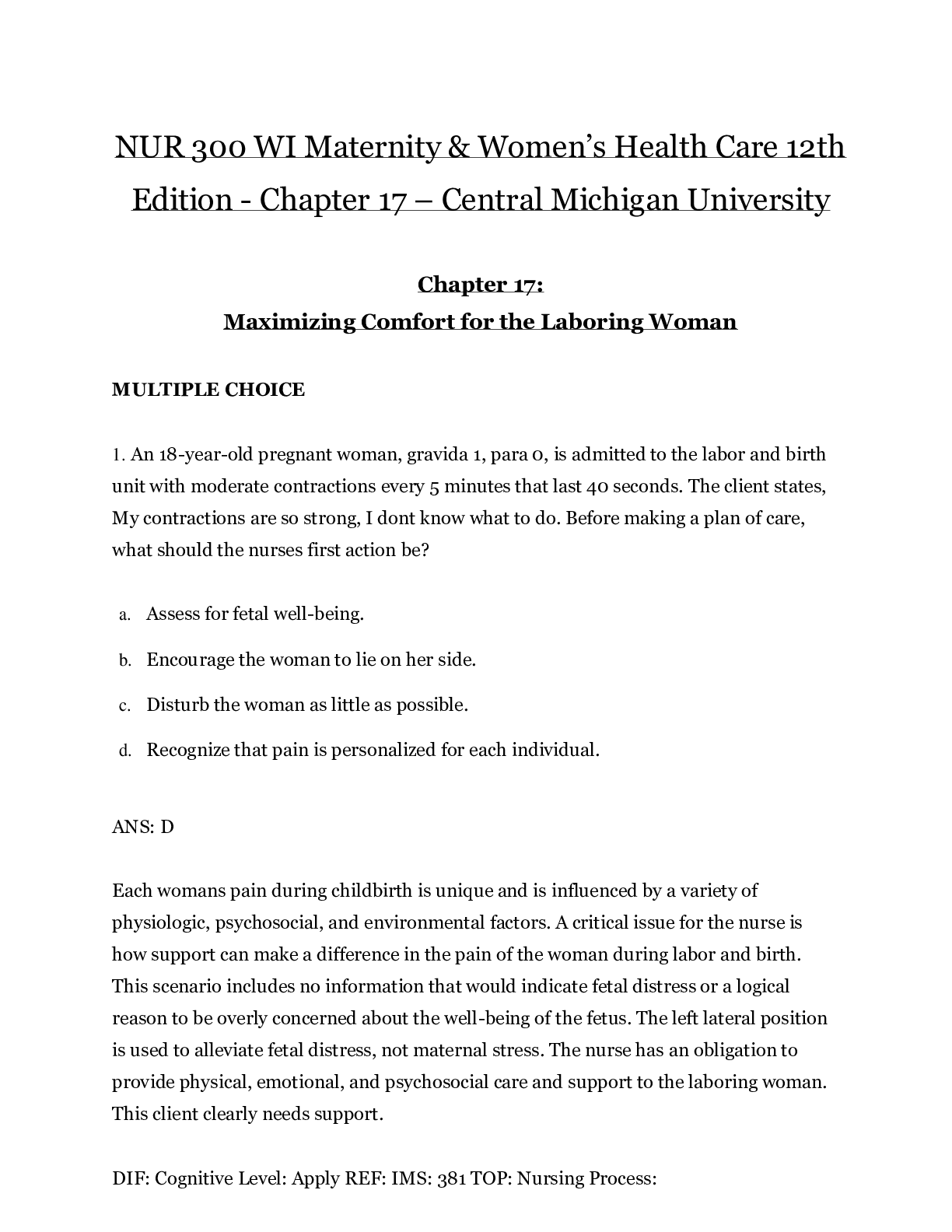
Reviews( 0 )
Document information
Connected school, study & course
About the document
Uploaded On
Jun 29, 2020
Number of pages
39
Written in
Additional information
This document has been written for:
Uploaded
Jun 29, 2020
Downloads
0
Views
28














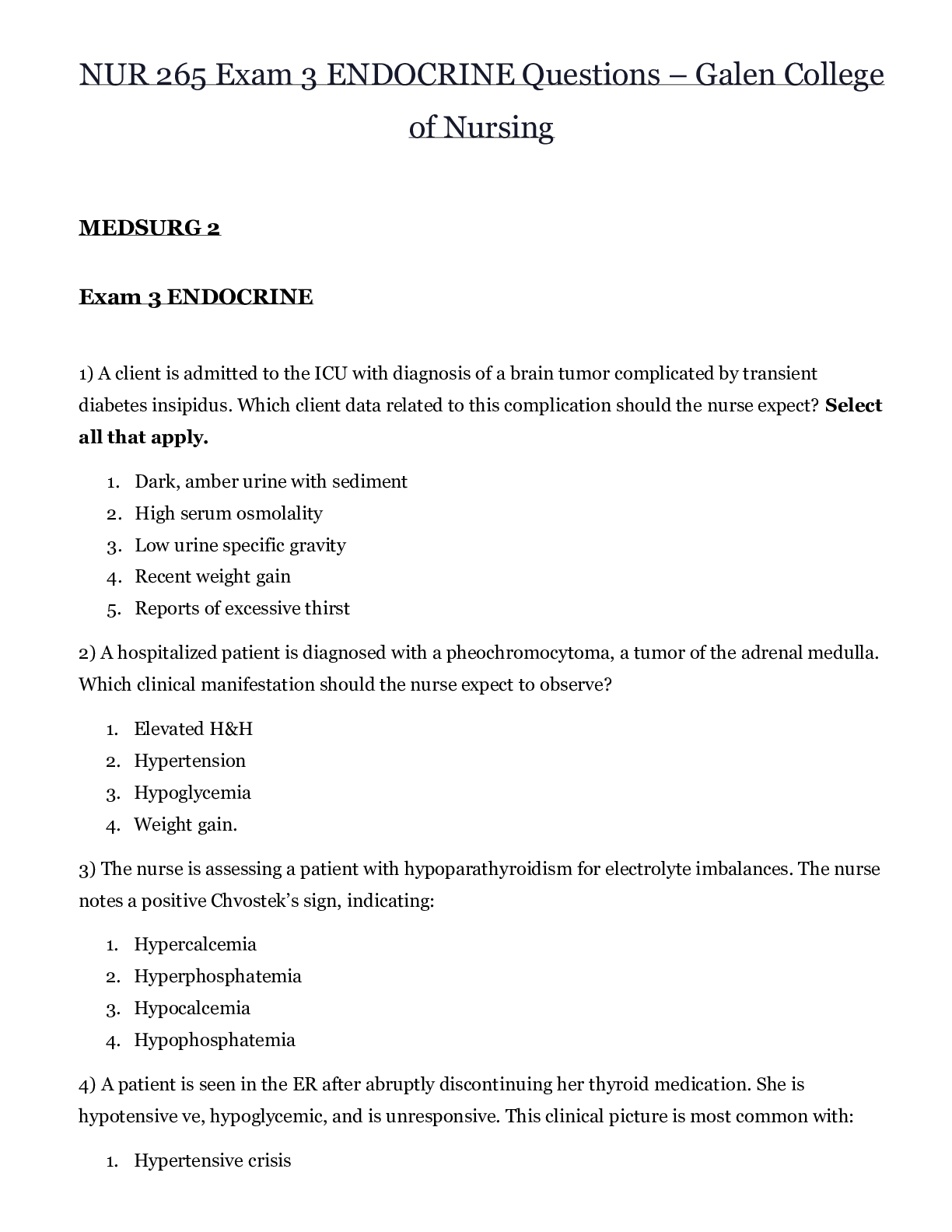
 – CHAMBERLAIN COLLEGE OF NURSING.png)
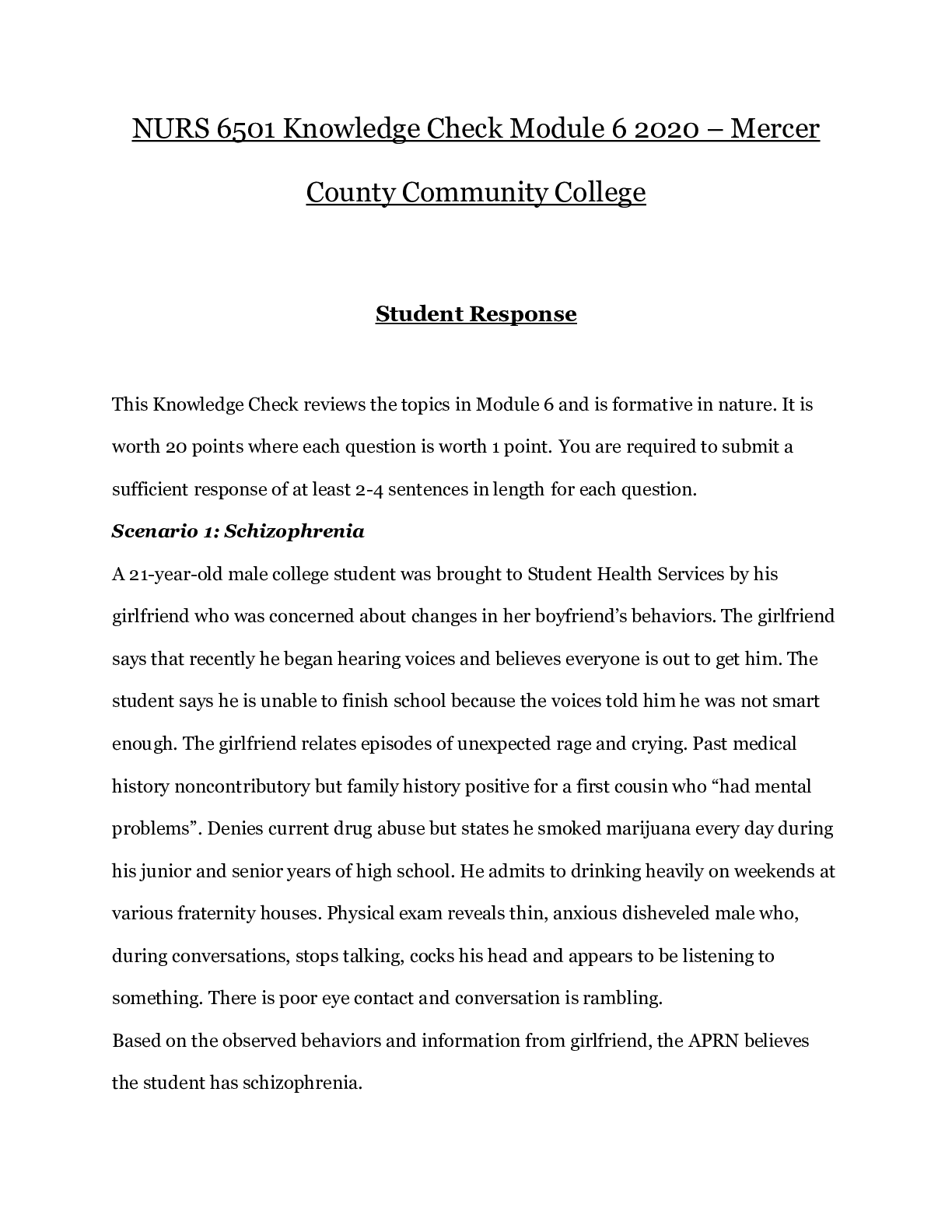
Test Bank Latest 2023.png)






